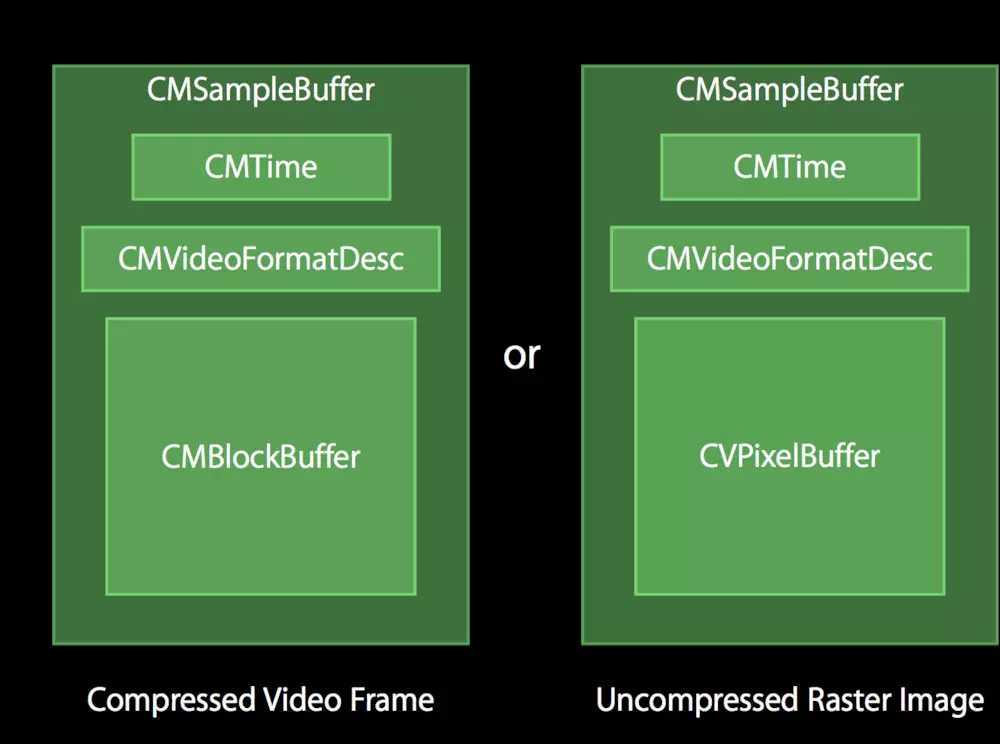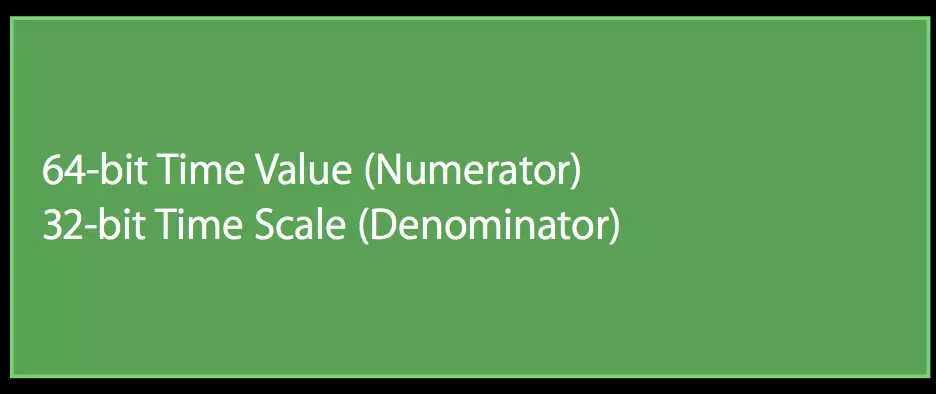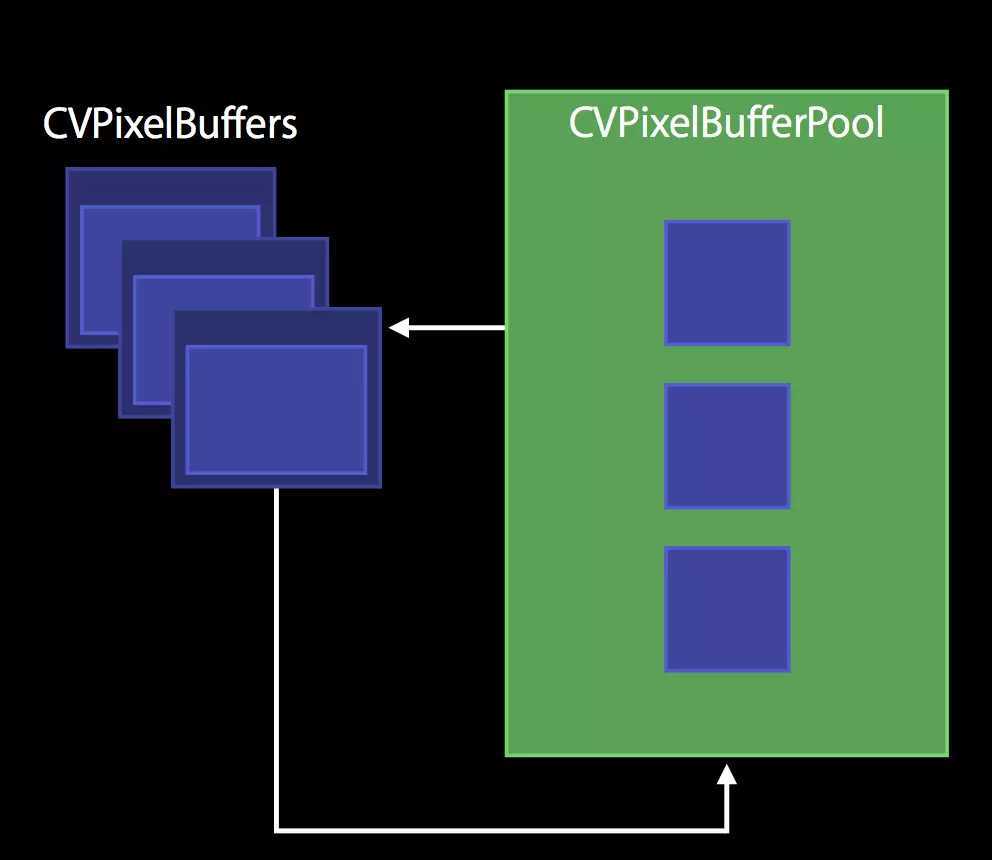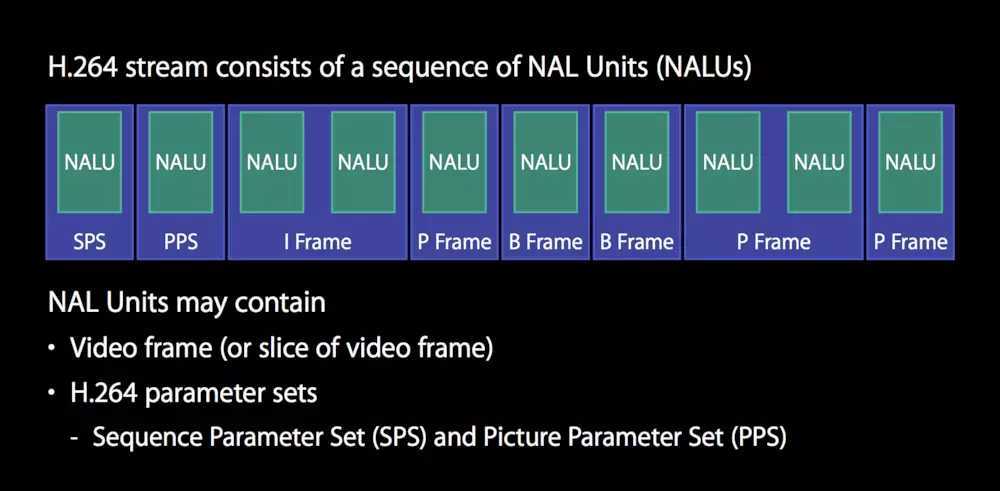标签:rda 前言 opengl es array tcap cfs log 获得 长度
VideoToolBox是iOS8之后,苹果开发的用于硬解码编码H264/H265(iOS11以后支持)的API。
对于H264还不了解的童鞋一定要先看下这边的H264的简介。
我们实现一个简单的Demo,从摄像头获取到视频数据,然后再编码成H264裸数据保存在沙盒中。
1. 创建初始化VideoToolBox

核心代码如下
- (void)initVideoToolBox {
dispatch_sync(encodeQueue , ^{
frameNO = 0;
int width = 480, height = 640;
OSStatus status = VTCompressionSessionCreate(NULL, width, height, kCMVideoCodecType_H264, NULL, NULL, NULL, didCompressH264, (__bridge void *)(self), &encodingSession);
NSLog(@"H264: VTCompressionSessionCreate %d", (int)status);
if (status != 0)
{
NSLog(@"H264: Unable to create a H264 session");
return ;
}
// 设置实时编码输出(避免延迟)
VTSessionSetProperty(encodingSession, kVTCompressionPropertyKey_RealTime, kCFBooleanTrue);
VTSessionSetProperty(encodingSession, kVTCompressionPropertyKey_ProfileLevel, kVTProfileLevel_H264_Baseline_AutoLevel);
// 设置关键帧(GOPsize)间隔
int frameInterval = 24;
CFNumberRef frameIntervalRef = CFNumberCreate(kCFAllocatorDefault, kCFNumberIntType, &frameInterval);
VTSessionSetProperty(encodingSession, kVTCompressionPropertyKey_MaxKeyFrameInterval, frameIntervalRef);
//设置期望帧率
int fps = 24;
CFNumberRef fpsRef = CFNumberCreate(kCFAllocatorDefault, kCFNumberIntType, &fps);
VTSessionSetProperty(encodingSession, kVTCompressionPropertyKey_ExpectedFrameRate, fpsRef);
//设置码率,均值,单位是byte
int bitRate = width * height * 3 * 4 * 8;
CFNumberRef bitRateRef = CFNumberCreate(kCFAllocatorDefault, kCFNumberSInt32Type, &bitRate);
VTSessionSetProperty(encodingSession, kVTCompressionPropertyKey_AverageBitRate, bitRateRef);
//设置码率,上限,单位是bps
int bitRateLimit = width * height * 3 * 4;
CFNumberRef bitRateLimitRef = CFNumberCreate(kCFAllocatorDefault, kCFNumberSInt32Type, &bitRateLimit);
VTSessionSetProperty(encodingSession, kVTCompressionPropertyKey_DataRateLimits, bitRateLimitRef);
//开始编码
VTCompressionSessionPrepareToEncodeFrames(encodingSession);
});
}
初始化这里设置了编码类型kCMVideoCodecType_H264,
分辨率640 * 480,fps,GOP,码率。
2. 从摄像头获取视频数据丢给VideoToolBox编码成H264

初始化视频采集端核心代码如下
//初始化摄像头采集端
- (void)initCapture{
self.captureSession = [[AVCaptureSession alloc]init];
//设置录制640 * 480
self.captureSession.sessionPreset = AVCaptureSessionPreset640x480;
AVCaptureDevice *inputCamera = [self cameraWithPostion:AVCaptureDevicePositionBack];
self.captureDeviceInput = [[AVCaptureDeviceInput alloc] initWithDevice:inputCamera error:nil];
if ([self.captureSession canAddInput:self.captureDeviceInput]) {
[self.captureSession addInput:self.captureDeviceInput];
}
self.captureDeviceOutput = [[AVCaptureVideoDataOutput alloc] init];
[self.captureDeviceOutput setAlwaysDiscardsLateVideoFrames:NO];
//设置YUV420p输出
[self.captureDeviceOutput setVideoSettings:[NSDictionary dictionaryWithObject:[NSNumber numberWithInt:kCVPixelFormatType_420YpCbCr8BiPlanarFullRange] forKey:(id)kCVPixelBufferPixelFormatTypeKey]];
[self.captureDeviceOutput setSampleBufferDelegate:self queue:captureQueue];
if ([self.captureSession canAddOutput:self.captureDeviceOutput]) {
[self.captureSession addOutput:self.captureDeviceOutput];
}
//建立连接
AVCaptureConnection *connection = [self.captureDeviceOutput connectionWithMediaType:AVMediaTypeVideo];
[connection setVideoOrientation:AVCaptureVideoOrientationPortrait];
}
这里需要注意设置的视频分辨率和编码器一致640 * 480. AVCaptureVideoDataOutput类型选用YUV420p。
摄像头数据回调部分
- (void)captureOutput:(AVCaptureOutput *)output didOutputSampleBuffer:(CMSampleBufferRef)sampleBuffer fromConnection:(AVCaptureConnection *)connection{
dispatch_sync(encodeQueue, ^{
[self encode:sampleBuffer];
});
}
//编码sampleBuffer
- (void) encode:(CMSampleBufferRef )sampleBuffer
{
CVImageBufferRef imageBuffer = (CVImageBufferRef)CMSampleBufferGetImageBuffer(sampleBuffer);
// 帧时间,如果不设置会导致时间轴过长。
CMTime presentationTimeStamp = CMTimeMake(frameNO++, 1000);
VTEncodeInfoFlags flags;
OSStatus statusCode = VTCompressionSessionEncodeFrame(encodingSession,
imageBuffer,
presentationTimeStamp,
kCMTimeInvalid,
NULL, NULL, &flags);
if (statusCode != noErr) {
NSLog(@"H264: VTCompressionSessionEncodeFrame failed with %d", (int)statusCode);
VTCompressionSessionInvalidate(encodingSession);
CFRelease(encodingSession);
encodingSession = NULL;
return;
}
NSLog(@"H264: VTCompressionSessionEncodeFrame Success");
}
3.框架中出现的数据结构
CMSampleBufferRef
存放一个或者多个压缩或未压缩的媒体数据;
下图列举了两种CMSampleBuffer。

CMTime
64位的value,32位的scale,media的时间格式;

CMBlockBuffer
这里可以叫裸数据;
CVPixelBuffer
包含未压缩的像素数据,图像宽度、高度等;
pixelBufferAttributes
CFDictionary包括宽高、像素格式(RGBA、YUV)、使用场景(OpenGL ES、Core Animation)

CVPixelBufferPool
CVPixelBuffer的缓冲池,因为CVPixelBuffer的创建和销毁开销很大

CMVideoFormatDescription
video格式,包括宽高、颜色空间、编码格式信息等;对于H264,还包含sps和pps数据;


这里编码完成我们先判断的是否为I帧,如果是需要读取sps和pps参数集,为什么要这样呢?
我们先看一下一个裸数据H264(Elementary Stream)的NALU构成

H.264裸流中,不存在单独的SPS、PPS包或帧,而是附加在I帧前面,存储的一般形式为
00 00 00 01 SPS 00 00 00 01 PPS 00 00 00 01 I帧
前面的这些00 00数据称为起始码(Start Code),它们不属于SPS、PPS的内容。
SPS(Sequence Parameter Sets)和PPS(Picture Parameter Set):H.264的SPS和PPS包含了初始化H.264解码器所需要的信息参数,包括编码所用的profile,level,图像的宽和高,deblock滤波器等。
上面介绍了sps和pps是封装在CMFormatDescriptionRef中,所以我们得先CMFormatDescriptionRef中取出sps和pps写入h264裸流中。
这就不难理解写入H264的流程了。
代码如下
// 编码完成回调
void didCompressH264(void *outputCallbackRefCon, void *sourceFrameRefCon, OSStatus status, VTEncodeInfoFlags infoFlags, CMSampleBufferRef sampleBuffer) {
NSLog(@"didCompressH264 called with status %d infoFlags %d", (int)status, (int)infoFlags);
if (status != 0) {
return;
}
if (!CMSampleBufferDataIsReady(sampleBuffer)) {
NSLog(@"didCompressH264 data is not ready ");
return;
}
ViewController* encoder = (__bridge ViewController*)outputCallbackRefCon;
bool keyframe = !CFDictionaryContainsKey( (CFArrayGetValueAtIndex(CMSampleBufferGetSampleAttachmentsArray(sampleBuffer, true), 0)), kCMSampleAttachmentKey_NotSync);
// 判断当前帧是否为关键帧
// 获取sps & pps数据
if (keyframe)
{
CMFormatDescriptionRef format = CMSampleBufferGetFormatDescription(sampleBuffer);
size_t sparameterSetSize, sparameterSetCount;
const uint8_t *sparameterSet;
OSStatus statusCode = CMVideoFormatDescriptionGetH264ParameterSetAtIndex(format, 0, &sparameterSet, &sparameterSetSize, &sparameterSetCount, 0 );
if (statusCode == noErr)
{
// 获得了sps,再获取pps
size_t pparameterSetSize, pparameterSetCount;
const uint8_t *pparameterSet;
OSStatus statusCode = CMVideoFormatDescriptionGetH264ParameterSetAtIndex(format, 1, &pparameterSet, &pparameterSetSize, &pparameterSetCount, 0 );
if (statusCode == noErr)
{
// 获取SPS和PPS data
NSData *sps = [NSData dataWithBytes:sparameterSet length:sparameterSetSize];
NSData *pps = [NSData dataWithBytes:pparameterSet length:pparameterSetSize];
if (encoder)
{
[encoder gotSpsPps:sps pps:pps];
}
}
}
}
CMBlockBufferRef dataBuffer = CMSampleBufferGetDataBuffer(sampleBuffer);
size_t length, totalLength;
char *dataPointer;
//这里获取了数据指针,和NALU的帧总长度,前四个字节里面保存的
OSStatus statusCodeRet = CMBlockBufferGetDataPointer(dataBuffer, 0, &length, &totalLength, &dataPointer);
if (statusCodeRet == noErr) {
size_t bufferOffset = 0;
static const int AVCCHeaderLength = 4; // 返回的nalu数据前四个字节不是0001的startcode,而是大端模式的帧长度length
// 循环获取nalu数据
while (bufferOffset < totalLength - AVCCHeaderLength) {
uint32_t NALUnitLength = 0;
// 读取NALU长度的数据
memcpy(&NALUnitLength, dataPointer + bufferOffset, AVCCHeaderLength);
// 从大端转系统端
NALUnitLength = CFSwapInt32BigToHost(NALUnitLength);
NSData* data = [[NSData alloc] initWithBytes:(dataPointer + bufferOffset + AVCCHeaderLength) length:NALUnitLength];
[encoder gotEncodedData:data];
// 移动到下一个NALU单元
bufferOffset += AVCCHeaderLength + NALUnitLength;
}
}
}
//填充SPS和PPS数据
- (void)gotSpsPps:(NSData*)sps pps:(NSData*)pps
{
NSLog(@"gotSpsPps %d %d", (int)[sps length], (int)[pps length]);
const char bytes[] = "\x00\x00\x00\x01";
size_t length = (sizeof bytes) - 1; //string literals have implicit trailing ‘\0‘
NSData *ByteHeader = [NSData dataWithBytes:bytes length:length];
//写入startcode
[self.h264FileHandle writeData:ByteHeader];
[self.h264FileHandle writeData:sps];
//写入startcode
[self.h264FileHandle writeData:ByteHeader];
[self.h264FileHandle writeData:pps];
}
//填充NALU数据
- (void)gotEncodedData:(NSData*)data
{
NSLog(@"gotEncodedData %d", (int)[data length]);
if (self.h264FileHandle != NULL)
{
const char bytes[] = "\x00\x00\x00\x01";
size_t length = (sizeof bytes) - 1; //string literals have implicit trailing ‘\0‘
NSData *ByteHeader = [NSData dataWithBytes:bytes length:length];
//写入startcode
[self.h264FileHandle writeData:ByteHeader];
//写入NALU数据
[self.h264FileHandle writeData:data];
}
}
结束编码后销毁session
- (void)EndVideoToolBox
{
VTCompressionSessionCompleteFrames(encodingSession, kCMTimeInvalid);
VTCompressionSessionInvalidate(encodingSession);
CFRelease(encodingSession);
encodingSession = NULL;
}
这样就完成了使用VideoToolbox 的H264编码。编码好的H264文件可以从沙盒中取出。
仅仅看流程不看代码肯定是学不会框架的,自己动手编码试试吧!
Demo下载地址:iOS-VideoToolBox-demo
标签:rda 前言 opengl es array tcap cfs log 获得 长度
原文地址:https://www.cnblogs.com/tangyuanby2/p/11449460.html